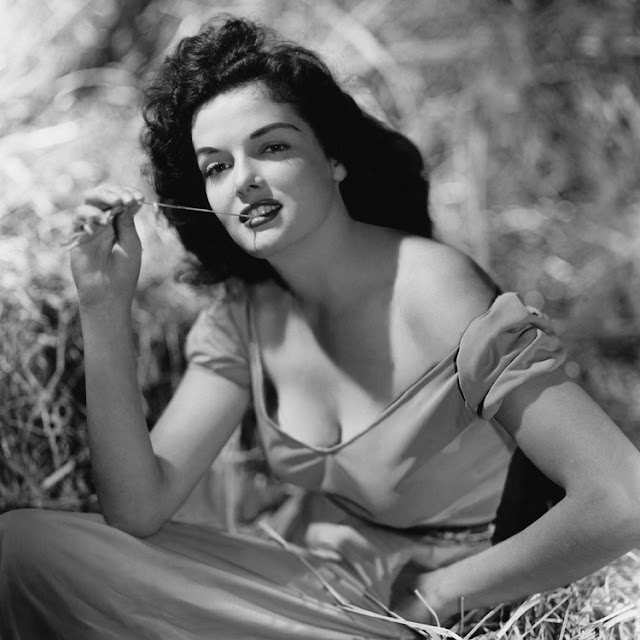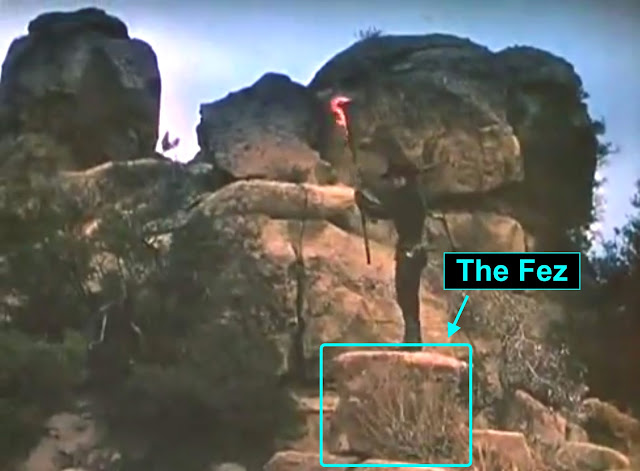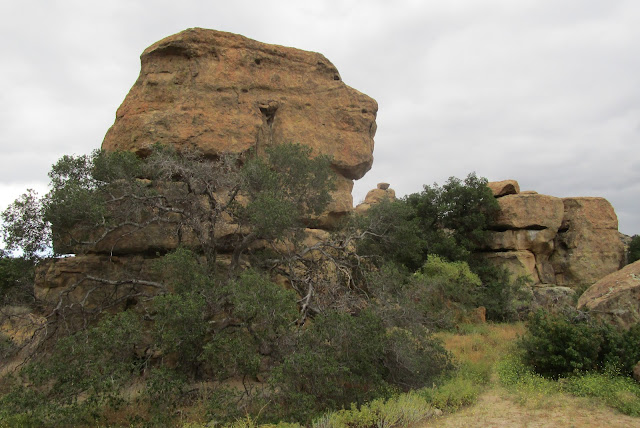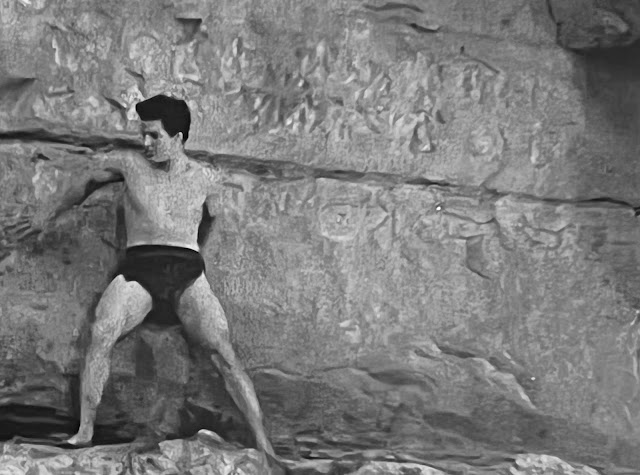Cecil B. DeMille, left, and Jerry Mathers ... as the Beaver
The lineup of uncredited bit players was interesting too, including a super-young Jerry Mathers — still about five years away from becoming famous as the Beaver on "Leave It to Beaver." Also on hand were Bing Crosby and Cecil B. DeMille ... yes, THAT Cecil B. DeMille.
"Have Gun — Will Travel" (1957): Richard Boone as Paladin, on "The Fez"
The main reason I'm bringing up "Son of Paleface" is to show off a particular rock at Iverson. You may have noticed, but with me, more often than not, it tends to be about the rocks.
The Fez (the rock), in the "Have Gun — Will Travel" episode "The Long Night"
I call it the Fez, and in "Have Gun — Will Travel," Richard Boone climbs on top of it to get the drop on some bad guys. The Iverson Ranch's Fez is upside-down from how we typically see the hat version.
A Fez (the hat)
Guy with a bad fake mustache, wearing a fez
When someone says, "Let me take you to the Casbah," and they really mean
it — i.e., it's not said as a joke, the way it usually is around here, often with a "huh-HWAHHH" in an exaggerated French accent somewhere in the same sentence — there's a good chance that person is wearing a
fez.
The Fez, as it appears in modern times
This is what the Fez — the rock — looks like today on its bed of rocks in the Garden of the Gods on the former Iverson Movie Ranch. The location is on public parkland, off Redmesa Road in Chatsworth, Calif.
Not that there'd be any doubt, but just in case, the Fez is highlighted here. You can find a map to this location near the bottom of this post.
See, it's shaped kind of like a fez, only upside-down. (They also come in blue.)
The Wilmer Valderrama character "Fez" on "That '70s Show" has nothing to do with the Iverson Movie Ranch or the rock called the Fez, but I wanted to mention him here to commemorate his status as a cultural reference point.
It's not exactly a positive cultural reference point, since almost everyone who ever caught an episode of "That '70s Show" hates the Fez character — with the possible exception of hard-core fans of the show, and how would they know? But like it or not, the Fez character did exist, and remains some kind of a reference point.
No need to feel sympathy for Valderrama over his universally panned role. The actor has done just fine in his post-Fez years, even playing himself once on "The Sopranos."
Wilmer Valderrama and Mandy Moore
Much more famously, Valderrama has had a celebrated dating life, punctuated by high-profile dalliances with younger women including Mandy Moore, Lindsay Lohan and Demi Lovato.
Lyric video for Demi Lovato's TMI "29" (2022)
Apparently, not all of those relationships left both parties feeling warm and fuzzy. Lovato, who turned 29 last year, seized on the opportunity to crush Valderrama — albeit without naming names — in her song "29," seemingly accusing him of taking advantage of her when he was 29 and she was 17.
But the actor has since settled down with model Amanda Pacheco, and the couple had their first child, a daughter, in February 2021.
Jane Russell (1942)
While we're on the subject of gorgeous women, this is what Jane Russell looked like back in 1942 ... about 10 years before playing Mike Delroy, a character with an unexpectedly male-sounding name, in "Son of Paleface."
Jane Russell in a promo still for "The Outlaw" (1943)
Here's a famous promo shot of Ms. Russell for the 1943 movie "The Outlaw," produced and directed by eccentric billionaire Howard Hughes (with some uncredited help from legendary director Howard Hawks).
The promo shot has also circulated in this orientation. Choose your poison.
Russell apparently spent a considerable amount of time in the hay for the promo shoot, as a number of photos came out of it — each one more revealing than the rest.
But there wouldn't have been much point in getting her in the hay and NOT making the most of it. I mean, for promotional purposes, of course.
Howard Hughes
Now, before you assume that Howard
Hughes, one of the richest and most powerful men in the world at the
time, might have exploited the situation for some pre-#MeToo shenanigans, that question has been blowin' in the wind since the '40s and the answer, especially from Jane Russell, has always come back: "Absolutely not."
But rather than ruminate on the romantic lives of people who aren't here to defend themselves, let's get back to the rock.
Here's a shot of Jane Russell's character standing on the Fez in "Son of Paleface."
The sequence is shot day-for-night, so the details don't exactly pop out — but there's the Fez, behind some dry brush. As for the Jane Russell character, there's no way that's the actual Jane Russell.
We can be reasonably sure it's not actually Jane Russell because, first of all, it doesn't really look like her. In fact, if you ask me, I'd say it looks more like a dude. (Update: Maybe not! See comments below.)
Sure, Jane's character is named "Mike," but in the movie, "Mike" is clearly not a dude.
If there's still any doubt about who might be standing on the Fez, it has to be a stunt person because he or she jumps off the rocks onto a nearby horse. Somehow I can't see Jane Russell agreeing to that.
Also, the Fez sequence is preceded by this shot of Jane, which appears to be done on a soundstage with better lighting and some of the Garden of the Gods rocks shown in rear projection.
Oblivious to whatever is going on around it and whoever might be climbing on top of it, the Fez holds down its spot in the frame throughout the location shoot, and can still be found in the exact same spot today.
Someone else who once stood on top of the Fez is Old Yeller — actually a movie dog named Spike, who played Old Yeller in the 1957 Disney movie that traumatized millions of young children.
One of "Old Yeller's" pivotal sequences was filmed just a few feet from the Fez, where the dog waged a heroic battle against a gang of feral pigs.
The outnumbered canine hero suffered serious injuries in the pig fight, sending the trajectory of the movie in a disturbing direction. I imagine at least a few of my readers recall the sad outcome as clearly as I do.
The bloody encounter between Old Yeller and the pigs took place in the same Garden of the Gods location where Ronald Reagan was once gunned down and Elvis Presley romanced one of his many screen girlfriends. Click here for photos and details on all three storylines.
The Fez has been popping up in movies for close to 100 years, if not longer. One of the oldest examples I could find is this shot from the early sound Western "The Utah Kid."
"The Utah Kid" was filmed so long ago they were still releasing movies in sepia tone.
Here's another glimpse of the Fez in "West of Carson City," which filmed all over the Iverson Movie Ranch.
People have been lured into standing, sitting, climbing, leaning and lounging on the Fez since Day One. In this shot Johnny and leading lady Peggy Moran avail themselves of its convenient flat surfaces.
Here's a better look at some of the key players in a promo still for "West of Carson City."
Even the Lone Ranger and Tonto once shared a moment at the Fez, during the fifth season of the TV series — the only season of the show to be shot in color.
In 1949 the Fez found its way into one of only a handful of films noir to be shot on the Iverson Ranch, turning up along with Robert Mitchum and Jane Greer in "The Big Steal."
I'm usually not a fan of colorization, but this is a rare occasion when it really added something because that old car looks great in baby blue.
If you ever happen to visit this spot, take a moment to try to figure out how they got that car up there.
When the Fez is viewed from this angle, we can see that it's part of an unusual grouping of more or less rectangular and square rocks — the "Four Square Rocks."
The Four Square Rocks also turn up sometimes in the movies, as seen in this promo still for "The Wild Westerners." That's the Fez in the top right corner of the frame.
A wider shot reveals that the Four Square Rocks are one of the smaller rockpiles positioned near the base of Tower Rock and its imposing rock neighbors.
If this promo still were in color, I imagine the Fez might be red with embarrassment over this extremely fake-looking shot of a fistfight between Whip Wilson and Iron Eyes Cody.
The Fez would probably prefer to hide behind the dry brush again, but we know where to find it.
The best way to get to the Fez is via the Garden of the Gods hiking trail. Park on Redmesa Road about a quarter-mile north of Santa Susana Pass Road, near the gate on the west side of the road. The rock's GPS coordinates are 34.273329, -118.612135.
Here's a link to audio of the Steely Dan song "The Fez." If the song isn't already stuck in your head after all this talk about fezzes, give it a listen and maybe it will be.
The sequence is shot day-for-night, so the details don't exactly pop out — but there's the Fez, behind some dry brush. As for the Jane Russell character, there's no way that's the actual Jane Russell.
We can be reasonably sure it's not actually Jane Russell because, first of all, it doesn't really look like her. In fact, if you ask me, I'd say it looks more like a dude. (Update: Maybe not! See comments below.)
Sure, Jane's character is named "Mike," but in the movie, "Mike" is clearly not a dude.
If there's still any doubt about who might be standing on the Fez, it has to be a stunt person because he or she jumps off the rocks onto a nearby horse. Somehow I can't see Jane Russell agreeing to that.
Also, the Fez sequence is preceded by this shot of Jane, which appears to be done on a soundstage with better lighting and some of the Garden of the Gods rocks shown in rear projection.
Oblivious to whatever is going on around it and whoever might be climbing on top of it, the Fez holds down its spot in the frame throughout the location shoot, and can still be found in the exact same spot today.
Someone else who once stood on top of the Fez is Old Yeller — actually a movie dog named Spike, who played Old Yeller in the 1957 Disney movie that traumatized millions of young children.
One of "Old Yeller's" pivotal sequences was filmed just a few feet from the Fez, where the dog waged a heroic battle against a gang of feral pigs.
The outnumbered canine hero suffered serious injuries in the pig fight, sending the trajectory of the movie in a disturbing direction. I imagine at least a few of my readers recall the sad outcome as clearly as I do.
The bloody encounter between Old Yeller and the pigs took place in the same Garden of the Gods location where Ronald Reagan was once gunned down and Elvis Presley romanced one of his many screen girlfriends. Click here for photos and details on all three storylines.
The Fez has been popping up in movies for close to 100 years, if not longer. One of the oldest examples I could find is this shot from the early sound Western "The Utah Kid."
"The Utah Kid" was filmed so long ago they were still releasing movies in sepia tone.
Here's another glimpse of the Fez in "West of Carson City," which filmed all over the Iverson Movie Ranch.
People have been lured into standing, sitting, climbing, leaning and lounging on the Fez since Day One. In this shot Johnny and leading lady Peggy Moran avail themselves of its convenient flat surfaces.
Here's a better look at some of the key players in a promo still for "West of Carson City."
Even the Lone Ranger and Tonto once shared a moment at the Fez, during the fifth season of the TV series — the only season of the show to be shot in color.
In 1949 the Fez found its way into one of only a handful of films noir to be shot on the Iverson Ranch, turning up along with Robert Mitchum and Jane Greer in "The Big Steal."
I'm usually not a fan of colorization, but this is a rare occasion when it really added something because that old car looks great in baby blue.
If you ever happen to visit this spot, take a moment to try to figure out how they got that car up there.
When the Fez is viewed from this angle, we can see that it's part of an unusual grouping of more or less rectangular and square rocks — the "Four Square Rocks."
The Four Square Rocks also turn up sometimes in the movies, as seen in this promo still for "The Wild Westerners." That's the Fez in the top right corner of the frame.
A wider shot reveals that the Four Square Rocks are one of the smaller rockpiles positioned near the base of Tower Rock and its imposing rock neighbors.
If this promo still were in color, I imagine the Fez might be red with embarrassment over this extremely fake-looking shot of a fistfight between Whip Wilson and Iron Eyes Cody.
The Fez would probably prefer to hide behind the dry brush again, but we know where to find it.
The best way to get to the Fez is via the Garden of the Gods hiking trail. Park on Redmesa Road about a quarter-mile north of Santa Susana Pass Road, near the gate on the west side of the road. The rock's GPS coordinates are 34.273329, -118.612135.
Don't make me do it without the Fez on!
Here's a link to audio of the Steely Dan song "The Fez." If the song isn't already stuck in your head after all this talk about fezzes, give it a listen and maybe it will be.






























-Old%20Yeller-wounded%20dog%2016.jpg)





-West%20of%20Carson%20City-PS-Johnny%20Mack%20Brown,%20Peggy%20Moran,%20Bob%20Baker.jpeg)
-Lone%20Ranger%20and%20Tonto%20at%20the%20Fez.jpg)








-Google%20Maps-Fez%20location-Garden%20of%20the%20Gods-noted.jpg)

-IR-Sphinx-southern%20profile-6359.jpeg)
-IR-Sphinx-southern%20profile-tight%20shot%20of%20carvings-6303.jpeg)
-IR-Sphinx-southern%20profile-6359-noted.jpeg)
-IR-Sphinx-southern%20profile-tight%20shot%20of%20carvings-6334.jpeg)


-IR-Sphinx-southern%20profile-tight%20shot%20of%20carvings-6334-zoomed%20in-noted.jpeg)
-IR-Sphinx-southern%20profile-tight%20shot%20of%20carvings-6334-zoomed%20in-noted%202.jpeg)
-Follow%20Me,%20Boys-Sphinx-carvings-Kurt%20Russell,%20age%2014.jpg)
-Follow%20Me,%20Boys-Sphinx-carvings-Kurt%20Russell,%20age%2014-noted.jpg)
-Follow%20Me,%20Boys-Sphinx-carvings-Kurt%20Russell,%20Greger%20Vigen.jpg)
-Follow%20Me,%20Boys-Sphinx-carvings-Kurt%20Russell,%20Greger%20Vigen-noted.jpg)
-Follow%20Me,%20Boys-Sphinx-carvings-Kurt%20Russell,%20Greger%20Vigen-rescue.jpg)
-Follow%20Me,%20Boys-Sphinx-carvings-Kurt%20Russell,%20Greger%20Vigen-rescue-zoomed%20in.jpg)
-Follow%20Me,%20Boys-Sphinx-carvings-Kurt%20Russell,%20Greger%20Vigen-rescue-zoomed%20in-noted.jpg)
-Honor%20Before%20Justice-Sphinx-carvings-8506.jpeg)
-Honor%20Before%20Justice-Sphinx-carvings-8506-noted.jpeg)







-IR-Sphinx-southern%20profile-medium%20shot%20of%20carvings-6340.jpeg)
-IR-Sphinx-southern%20profile-medium%20shot%20of%20carvings-6340-noted%202.jpeg)
-IR-Sphinx-southern%20profile-medium%20shot%20of%20carvings-6340-noted%203.jpeg)
-IR-Sphinx-southern%20profile-medium%20shot%20of%20carvings-6340-noted%204.jpeg)
-IR-Sphinx-southern%20profile-medium%20shot%20of%20carvings-6340-noted%205.jpeg)
-IR-Sphinx-southern%20profile-tight%20shot%20of%20carvings-esp%20top%20level-6326.jpeg)
-IR-Sphinx-southern%20profile-tight%20shot%20of%20carvings-esp%20top%20level-6326-noted.jpeg)
-GoG:Sphinx-Assitant%20Director%20Fred%20Fleck-scouting%20locations-Bison%20Archives.jpg)
-GoG:Sphinx-Assitant%20Director%20Fred%20Fleck-scouting%20locations-Bison%20Archives-noted.jpg)
-GoG:Sphinx-Assitant%20Director%20Fred%20Fleck-scouting%20locations-Bison%20Archives-zoomed%20in%20on%20carvings%20area.jpg)
-GoG:Sphinx-Assitant%20Director%20Fred%20Fleck-scouting%20locations-Bison%20Archives-zoomed%20in%20on%20carvings%20area-noted.jpg)
-GoG:Sphinx-Bison%20Archives-zoomed%20in%20on%20carvings%20area-Razorback%20on%20Sphinx%20w%20University%20of%20Arkansas%20logo.png)
-IR-Sphinx-southern%20profile-medium%20shot%20of%20carvings-razorback-6337-noted.jpeg)
-IR-Sphinx-southern%20profile-medium%20shot%20of%20carvings-razorback-6337-noted%202.jpeg)
-GoG:Sphinx-Assitant%20Director%20Fred%20Fleck-scouting%20locations-Bison%20Archives-zoomed%20in%20on%20carvings%20area-noted%202.jpg)
-GoG:Sphinx-Assitant%20Director%20Fred%20Fleck-scouting%20locations-Bison%20Archives-zoomed%20in%20on%20carvings%20area%202-noted.jpg)
%20and%202022-THEN%20AND%20NOW-GoG:Sphinx-southern%20profile-carvings%20area.jpg)
%20and%202022-THEN%20AND%20NOW-GoG:Sphinx-southern%20profile-carvings%20area-noted.jpg)
-IR-Sphinx-southern%20profile,%20showing%20carvings-6322.jpeg)
.jpeg)









-Google%20aerial-Garden%20of%20the%20Gods%20with%20trail%20to%20rock%20carvings-noted.jpg)
-GoG:Sphinx-Assitant%20Director%20Fred%20Fleck-scouting%20locations-Bison%20Archives.jpg)
-IR-Sphinx-southern%20profile-tight%20shot%20of%20carvings-esp%20top%20level-6326-noted%202.jpeg)